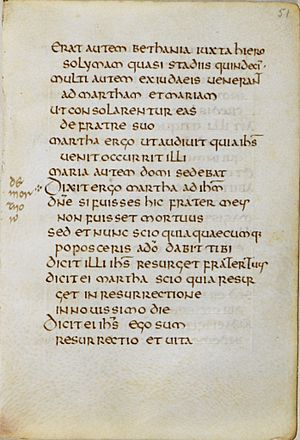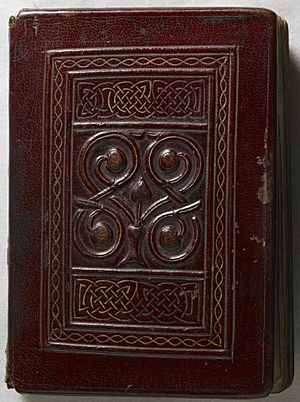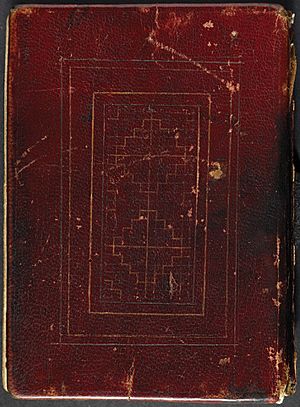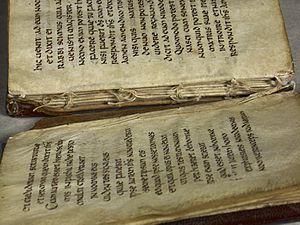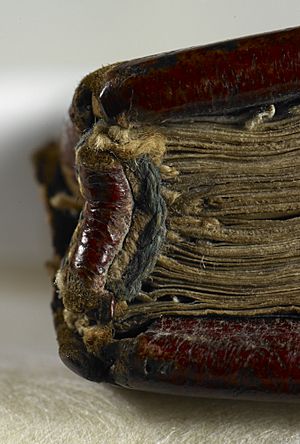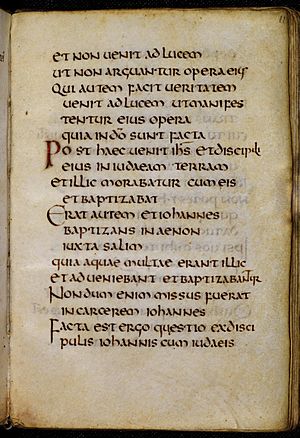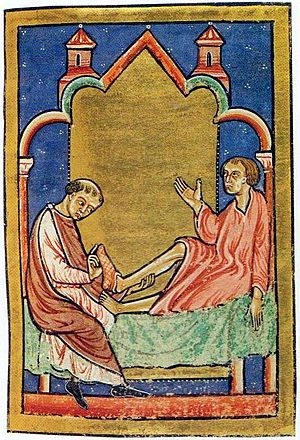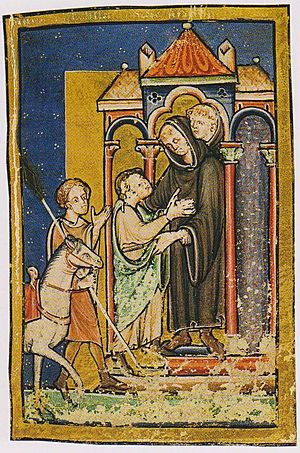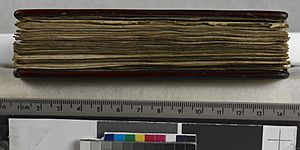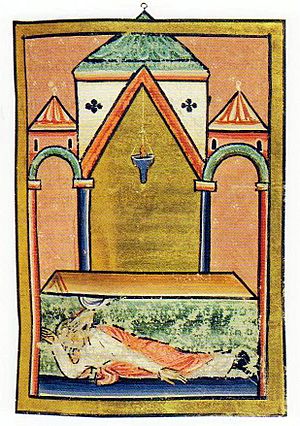St Cuthbert Gospel facts for kids
The St Cuthbert Gospel is a very old and special book from the early 700s. It's a small gospel book written in Latin. What makes it truly amazing is its beautiful leather cover. This cover is the oldest known Western bookbinding that still exists! Both the 94 pages, made from vellum (a type of treated animal skin), and the binding are in incredible condition for a book this old.
This tiny book is only about 13.8 by 9.2 centimeters (about 5.4 by 3.6 inches). It's one of the smallest Anglo-Saxon manuscripts we still have. The text inside is the Gospel of John, written in a clear and simple style.
The book is named after Saint Cuthbert, a famous saint from Lindisfarne in North East England. It was placed in his tomb probably a few years after he died in 687 AD. For a long time, people thought it was Cuthbert's own personal copy of the Gospel. Now, experts believe it was made shortly after his death. It was likely a gift from Monkwearmouth–Jarrow Abbey, where it was written. It was probably put in St Cuthbert's coffin when his body was moved behind the altar at Lindisfarne in 698 AD.
The book stayed with Cuthbert's coffin as it traveled for many years. This happened after 875 AD because of Viking invasions. The journey ended at Durham Cathedral. In 1104, the book was found inside the coffin when Cuthbert's burial was moved again within the cathedral. It was kept there with other special items. Important visitors could even wear the book in a leather bag around their necks!
After King Henry VIII closed down monasteries in England (1536-1541), the book likely went to private collectors. Eventually, it was given to Stonyhurst College, a school in Lancashire.
From 1979, the book was on loan to the British Library. On July 14, 2011, the British Library started a campaign to buy the book for £9 million. They announced on April 17, 2012, that they had bought it! The book is now part of the British Library's collection.
The library plans to show the Gospel in London and Durham equally. They call it "the earliest surviving intact European book and one of the world's most significant books." The Cuthbert Gospel has been in exhibitions in Durham and London. It also spends time "resting" when not on display. A new book about the Gospel was published in 2015. This book suggests the Gospel was made between 700 and 730 AD, a bit later than previously thought.
Contents
What is the St Cuthbert Gospel?
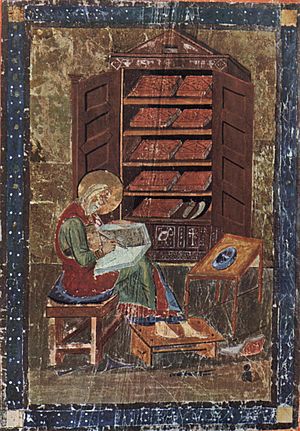
The St Cuthbert Gospel is a small book, about 13.8 by 9.2 centimeters (5.4 by 3.6 inches). It contains the Gospel of St John. The text is written in a special style called uncial script on 94 pages made of vellum. It has wooden covers wrapped in red leather with designs carved into them.
Why is the St Cuthbert Gospel Important?
The St Cuthbert Gospel is very important for two main reasons. First, it is the oldest complete European book that still has its original binding. Second, it is connected to Saint Cuthbert, a famous Anglo-Saxon saint from the 600s.
A tiny picture in another old book, the Codex Amiatinus, shows the Prophet Ezra writing in his library. This picture shows several books that look similar to the St Cuthbert Gospel. They are bound in red and have geometric designs. These pictures might have been based on an old Italian Bible that was brought to Jarrow.
Most old books from this time that still exist have fancy covers made of precious metals and jewels. These were called "treasure bindings." They were used for church services or as special religious objects. The St Cuthbert Gospel, with its leather cover, is different. It was likely used more often and kept in libraries. Very few simple, early leather bindings have survived. This is because book covers usually wore out and were replaced. Also, old collectors often didn't think plain historical bindings were worth keeping.
What is the Text Like?
The text in the St Cuthbert Gospel is a very good copy of the Gospel of John. It belongs to a group of texts called the "Italo-Northumbrian" family. Other famous books from this family include the Codex Amiatinus and the Lindisfarne Gospels. This group of texts probably came from an old "Neapolitan Gospelbook" brought to England from near Naples, Italy.
The book has no fancy pictures or decorations. Only the first letters of some sections are larger or slightly decorated. Some chapter beginnings are marked in red. Sir David M. Wilson, a historian, said that "some manuscripts are so beautifully written that illumination would seem only to spoil them." This means the writing itself is so beautiful that it doesn't need extra art.
The pages have faint lines pressed into them, made with a sharp tool. These lines helped the scribe write neatly. The book starts with 19 lines per page. But at page 42, it changes to 20 lines per page. This change might have happened because they were running low on the very fine vellum.
Four passages in the book are marked in the margin. These passages were used as readings for Masses for the Dead (funeral services) in the mid-7th century. This suggests the book was used at least once for a Mass for the Dead. Perhaps this happened when Cuthbert's body was moved in 698. In the picture, you can see a cross marking the start of a reading. The words de mortuorum ("for the dead") are written next to it.
The Unique Binding
The original red goatskin binding is the oldest complete Western binding we know of. It's also a rare example of decorated leatherwork from the Insular period. The front cover has color and a raised design, which is unique for early medieval bindings. The geometric patterns, with their two-stranded interlace, are similar to designs found in illuminated manuscripts from the Insular period. They also share similarities with Anglo-Saxon metalwork and designs from Coptic art (ancient Egyptian Christian art).
The cover designs use three colors that fill engraved lines. These now look like two shades of yellow and a dark blue-grey. The dark color was described as blue in older records. Recent tests show the yellow is orpiment and the blue-grey is indigo. The colors have faded differently over time, which affects how the designs look today.
Experts believe the binder was very skilled. One analysis suggests the designs were meant to follow complex geometric patterns. However, small mistakes during the making mean the finished covers are not perfectly precise.
The text was likely written at Monkwearmouth–Jarrow. But the binding might have been added at Lindisfarne. The plant designs are similar to those on a portable altar found in Cuthbert's coffin.
Front Cover Details
The front cover's decoration is divided into sections with raised lines. The middle section has a plant design that looks like a chalice (a special cup) with a bud and swirling vine stems, fruit, and small leaves. Above and below this, there are sections with interlace patterns. These three designs are surrounded by a border with more interlace.
Vine scrolls were very common in later Anglo-Saxon art, often mixed with interlace. The combination of different designs within a framed layout is typical of art from Northumbria. Interlace patterns might have been thought to have a protective power.
The two interlace panels use the same design. They are symmetrical, except for the top left part of the upper panel, which is different. The lines forming the interlace are colored in dark blue/black and bright yellow. The way the colors are used changes between the panels. These small differences suggest the design was done by hand, without using tools like compasses.
Back Cover Details
The back cover is simpler. It has no raised parts and only geometric designs made of engraved lines. These lines are filled with bright yellow and the dark color (which was once blue). Inside several rectangular frames, there's a central panel with a grid of tiny squares. Lines on this grid are engraved and colored in yellow to form two stepped "crosses." The rest of the lines on the grid are colored in the dark color. This design is similar to patterns found on "carpet pages" in old manuscripts and on the famous Sutton Hoo shoulder-clasps. The outer frames are not perfectly aligned with the inner panel. You can even see traces of a first attempt at one of the lines that was not colored in.
How it was Made
Even though the binding was never taken apart before the British Library bought it, we know a lot about how it was made. Because of wear and tear, experts could look closely at much of the binding.
The raised lines on the front cover were made by gluing cord to the wooden board and then shaping the leather over it. This technique came from Coptic binding (an ancient Egyptian binding style). The chalice and plant design on the front was built up using a clay-like material under the leather. This was discovered using CT-scans.
The wooden boards of the covers are now thought to be birch wood. This was unusual for later bindings but was easy to find in northern England. Both boards have holes where the binding threads were laced through. The front cover has extra holes for the cords that create the raised lines.
The book uses a special type of stitching called "Coptic sewing." This method uses small threads to hold the pages together and attach them to the covers. Normal Western binding uses thicker cords across the spine. Coptic sewing is also found in the earliest leather bookbindings from Egypt. The St Cuthbert Gospel's binding is very similar to another small Irish book, the Cadmug Gospels, which is about 50 years younger.
When was the Book Made?
The book itself doesn't have a date. But experts have figured out a likely time it was made. This is based on its palaeography (the study of old handwriting) and facts about Cuthbert's burial. After the British Library bought the book, the dating was updated.
Experts now believe the script was written around 710–730 AD. The decoration on the covers is dated to about 700–730 AD.
The writing style is called "capitular" uncial. Scribes from Northumbria copied Italian manuscripts very carefully. But they added small details that gave their writing a unique and beautiful style.
A very important book for dating is the Codex Amiatinus. This huge Bible left Wearmouth-Jarrow on June 4, 716 AD, heading for Rome. The dedication page of this book can be dated to around May 716 AD. The main text was probably finished some years earlier. By comparing the writing styles, experts can place the St Cuthbert Gospel in a timeline of books made at Wearmouth-Jarrow.
Parts of another gospel book, now with the Utrecht Psalter, were written by the same scribe as the Cuthbert Gospel. This suggests they were made around the same time.
Based on the handwriting, experts like T. Julian Brown believed the Cuthbert manuscript was written after the main text of the Codex Amiatinus, which was finished after 688 AD. Looking at the history of Cuthbert's burial, this means the book was made after his death in 687 AD but possibly before his body was moved to the high altar in 698 AD. If this is true, the book was not Cuthbert's personal possession. Instead, it might have been made specifically to be placed in his coffin.
The Book's Journey Through History
Cuthbert's Life and Times
Cuthbert was an Anglo-Saxon man, possibly from a noble family. He was born in the Kingdom of Northumbria around the 630s. This was about ten years after King Edwin became Christian. Spreading Christianity throughout the kingdom was a big task during Cuthbert's life.
There was often tension between the Roman and Irish Christian traditions. Cuthbert, though taught in the Irish way, accepted the Roman customs after the Synod of Whitby in 664. Early stories about him focus on the many miracles that happened around him. He was a tireless traveling priest, bringing the Christian message to remote villages. He was also good at impressing kings and nobles. Unlike some others, he lived a very simple life. When he could, he lived as a hermit, but still welcomed many visitors.
He decided to become a monk after seeing a vision on the night that St Aidan died in 651. Aidan was the founder of Lindisfarne. Cuthbert quickly became a guest-master at Ripon monastery. Around 662, he became prior at Melrose, and around 665, he went to Lindisfarne as prior. In 684, he became Bishop of Lindisfarne. But by late 686, he resigned and went back to his hermitage, feeling he was about to die. He died on March 20, 687, and was buried at Lindisfarne.
At Lindisfarne
The St Cuthbert Gospel was first written about in 1104. But it's believed to have been buried with Cuthbert at Lindisfarne. It likely stayed with his body during the long journeys caused by Viking invasions two centuries later.
Cuthbert was first buried in a stone coffin in the church at Lindisfarne. Eleven years after his death, his remains were moved behind the altar. This was because he was recognized as a saint. When his coffin was opened, his body was said to be perfectly preserved, or incorrupt. This amazing event led to Cuthbert becoming a very popular saint in Northern England.
Many miracles were said to happen through his prayers or near his remains. For example, Alfred the Great, King of Wessex, was inspired by a vision of Cuthbert in his fight against the Danes. The royal family of Wessex, who became the kings of England, showed great devotion to Cuthbert. This also helped unite the English kingdom. The historian Bede wrote about St Cuthbert around 720 AD. Cuthbert has been called "perhaps the most popular saint in England" before Thomas Becket. In 698, Cuthbert was reburied in a decorated oak coffin, now known as St Cuthbert's coffin. The book was believed to have been made for this event and placed in his coffin then. However, new dating suggests it was made up to 30 years after 698.
Fleeing the Vikings
In 793, Viking raiders attacked Lindisfarne. But Cuthbert's shrine seemed to be safe. In 875, the Danish leader Halfdene moved north. Eardulf, the Bishop of Lindisfarne, decided the monastery had to be left. The whole community, including families, prepared to leave.
It was possibly at this time that a shelf was put inside Cuthbert's coffin. This shelf likely held the St Cuthbert Gospel, which was found there in 1104. It might also have held the Lindisfarne Gospels and other books. The community also took bones of other saints, like St Aidan, and the head of King Oswald of Northumbria. These were carefully wrapped and labeled. Cuthbert's coffin was carried by seven young men.
They traveled inland and spent months near the River Derwent. Then they moved back east and found a resting place at Craike. Over the next century, the Vikings in the north slowly became Christian. Cuthbert's shrine became important to them too. The community settled at Chester-le-Street in 883, building St Cuthbert's Church. In 995, another Danish invasion made them flee south to Ripon. After a few months, they returned. Their wagon got stuck near Durham, which was then just a small farm area. People believed Cuthbert wanted to settle there, so the community built a new stone church, which was the start of Durham Cathedral.
At Durham Cathedral
In 1104, Cuthbert's tomb was opened again. His remains were moved to a new shrine in the partly built Norman cathedral. A monk wrote that when they opened the inner coffin, they saw "a book of the Gospels lying at the head of the board." Bishop Flambard, during his sermon, showed the people "a Gospel of Saint John in miraculously perfect condition." It had a red leather container with a worn silk strap. The book itself has a note from the 1100s saying it was found during this move.
The book stayed at Durham through the Middle Ages. It was kept as a relic in three red leather bags. Visitors were allowed to see it, and important guests could even wear it around their necks. A monk named Reginald of Durham wrote that "anyone approaching it should wash, fast and dress in an alb before touching it." He also wrote about a scribe who got sick because he touched it with unwashed hands after eating. Books treated as relics were common in Celtic Christianity.
Another copy of the Gospel of John was also linked to Cuthbert. Saint Boisil, Cuthbert's teacher, read from his own Gospel of John with Cuthbert. Some thought this was the St Cuthbert Gospel. But experts now believe they are different books.
After the Reformation
The book likely stayed at Durham until King Henry VIII closed the monasteries around 1540. Later, in the 1600s, it was recorded in the library of a scholar named Thomas Allen. But it wasn't in a later list of his books. For about a century, no one knows where it was.
An 18th-century note says the St Cuthbert Gospel was given by the 3rd Earl of Lichfield to a Jesuit priest, Thomas Phillips. Phillips then gave it to the English Jesuit College in Liège in 1769. The book was owned by the British Jesuits until 2012. For most of this time, it was in the library of Stonyhurst College.
The book was first shown to the public in London in 1806. A letter about it was read to the London Society of Antiquaries. The writer, Bishop John Milner, connected the book to Cuthbert. He compared its writing to the Lindisfarne Gospels. But he thought the binding was from the time of Queen Elizabeth! Later, in the 1800s, people realized the binding was original and the oldest in Europe. Scholars praised the book's beauty and the accuracy of its text.
From 1950 to Today
From 1950 onwards, the binding was studied many times by Roger Powell, a leading bookbinder. He had also rebound the Book of Kells. Powell wrote chapters about the binding in two important books about the St Cuthbert Gospel. In 1969, T.J. (Julian) Brown published a detailed study. He argued that the manuscript was made close to 698 AD, which was generally accepted.
The book was loaned to the British Library in 1979. It was often on display there. Despite some small damages, the book is in excellent condition for its age.
In 2011, the British Library agreed to buy the book from the Jesuits for £9 million. They launched a public appeal to raise the money. They received large donations from organizations like the National Heritage Memorial Fund and the Art Fund. By April 2012, they had raised enough money and completed the purchase. The purchase included an agreement that the book would be shown equally in London and the North East of England.
The book was displayed at the British Library and then in Durham in 2013. Since then, it has been shown in both London and Durham, with periods of "resting" when it's not on display. All the pages of the book can be seen online on the British Library website.
The Gospel of John as a Protective Charm
For a long time, there was a tradition of using copies of the Gospel of John, or parts of it, as a protective charm or for healing. This was especially common in early medieval Britain and Ireland. Books containing only one gospel are very rare, and most known examples are of John.
Some church leaders, like Saint Jerome, didn't approve of this use. But others, like John Chrysostom and Gregory the Great, accepted it. Bede's Life mentions that Cuthbert fought against the use of charms in villages. However, he might have seen a difference between charms based on Christian texts and other types of charms.
The size of the Cuthbert Gospel places it among the "pocket gospels" of the Insular tradition. There are eight Irish examples of these small books. Most of them contain all four gospels. There was also a tradition of even smaller books, often used as charms. For example, a tiny manuscript of John, only 7.2 by 5.6 centimeters, was found in a reliquary in France.
Julian Brown concluded that the three Latin manuscripts of John "seem to attest an early medieval practice of placing a complete Gospel of St. John in a shrine, as a protective amulet." This suggests the St Cuthbert Gospel was placed in Cuthbert's coffin to protect it.
Where Has the Book Been Shown?
Besides being regularly displayed at the British Museum and British Library, the St Cuthbert Gospel has been in these special exhibitions:
- 1862, Victoria & Albert Museum, Loan Exhibition
- 1930, Victoria & Albert Museum, Medieval English Art
- 1987, Durham Cathedral Treasury, An exhibition of manuscripts brought together at Durham to celebrate the saint's 1300th anniversary and the work of his early community
- 1991, British Museum, The Making of England: Anglo-Saxon Art and Culture AD 600–900
- 1996, Laing Art Gallery, Newcastle upon Tyne, Treasures from the Lost Kingdom of Northumbria
- 1997, British Museum, The Heirs of Rome: The Shaping of Britain AD 400–900
- 2003, British Library, Painted Labyrinth: The World of the Lindisfarne Gospels
- 2007, British Library, Sacred: Discover What We Share
- 2013, Palace Green Library, Durham University, in an exhibition that also included the Lindisfarne Gospels and items from the Staffordshire Hoard.
- 2014, Palace Green Library, Durham, Book binding from the Middle Ages to the modern day.
- 2018/19, British Library, Anglo-Saxon Kingdoms: Art, Word, War
- 2022, Laing Art Gallery, Newcastle upon Tyne, The Lindisfarne Gospels
A digital version of the manuscript was made for the Apple iPad. It was shown at the British Library in April 2012.
|
See also
- List of most expensive books and manuscripts



